The Surface 3 Review
by Brett Howse on May 4, 2015 9:00 AM ESTSystem Performance
Since the Surface 3 is a tablet that can replace your laptop, comparisons will be made between both devices. Because the new tablet is running full Windows 8.1 x64, it is possible to run the full benchmark suite that we have for laptops. On the tablet side, there are not a lot of cross-platform benchmarks so the only thing that can really be used is browser based tests. It is not ideal, but we have to work with what we have.
To summarize the Surface 3, it is powered by the top model of the latest Intel Atom 14nm stack. The Atom x7-Z8700 is a quad-core processor with a base frequency of 1.6 GHz. The CPU can turbo up to a maximum of 2.4 GHz, and all of this is done within a 2 watt Scenario Design Power. The review unit that I received is the $499 unit, so it only has 2 GB of LPDDR3 memory rather than the 4 GB offered on the higher priced model.
For comparisons against tablets, I have selected a sampling of several devices that have already been reviewed. Some of the devices are running on ARM processors, and several of the Windows ones run on Intel Core M, with a few more running on previous Atom architectures. To compare this device against any other device we have tested, please check out our Mobile Bench.
Tablet Performance
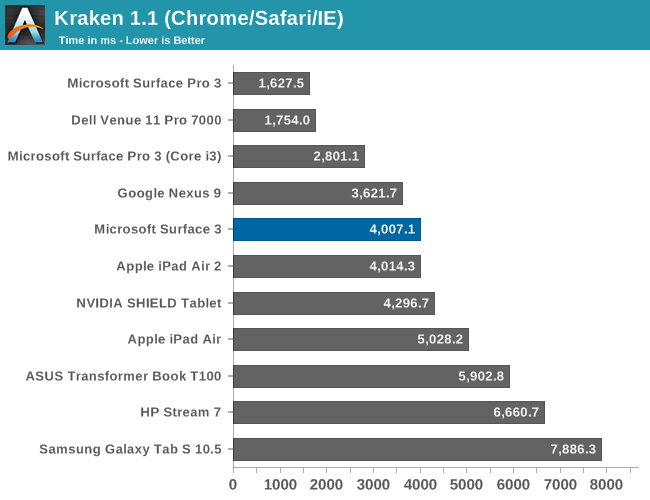
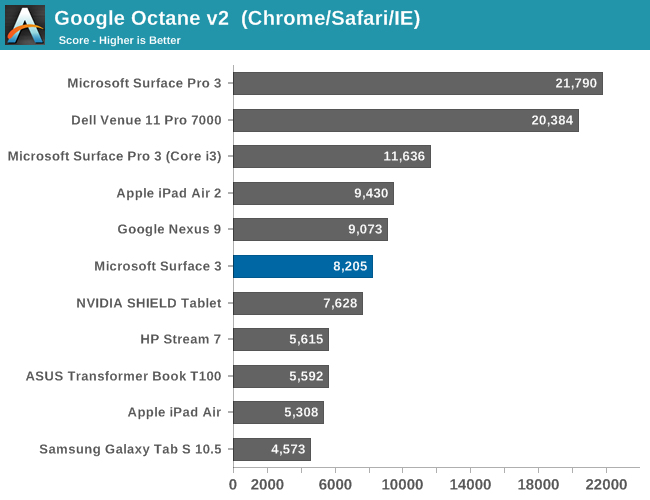

Since we just have web benchmarks to compare against other platforms, it does make it difficult to get a true feel for how Atom compares to the best, but when comparing to ARM processors it is fairly competitive. All of the web benchmarks are done using Chrome (hopefully we can switch to Microsoft Edge soon) because IE 11 has pretty awful javascript performance. Atom is a long ways off of the Core series in the Surface Pro line, and well back of the Core M powered Dell Venue 11 Pro tablet. There is a big jump in performance compared to the Bay Trail ASUS T100 and HP Stream 7. That is important since Cherry Trail is not a big architecture update, but mostly a process shrink, so the 14 nm processes can keep everything running at higher frequencies in the same power envelope.
Laptop Performance
By attaching the keyboard, the Surface 3 becomes a pretty reasonable laptop, so to see how much of a performance drop off there is with tablet class parts, the Surface 3 was run through our Laptop suite as well. The Atom is also equipped with eMMC storage, and some of the tests like PCMark take storage into account. Other benchmarks like Cinebench and x264 are CPU only. To compare the Surface 3 against any other laptop we have tested, please use our Laptop Bench.
PCMark

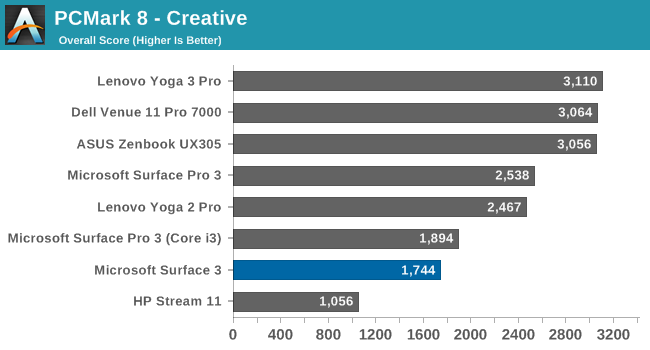
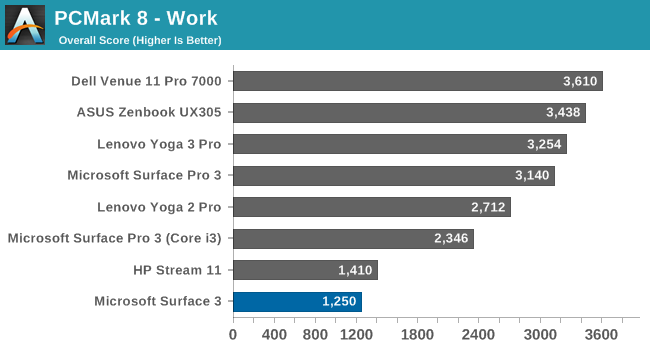
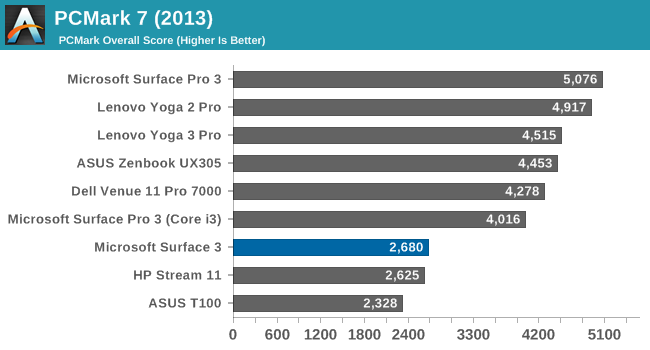
PCMark 8 from Futuremark has several benchmarks within it, all with the goal of simulating real-world use cases for each of the scenarios. It includes Home, Creative, Work, and Storage benchmarks. The workloads generally include both burst and sustained performance. The Atom can’t compete with the bigger Core pieces, but it is actually surprisingly close to the Core i3 Surface Pro 3. I think this is less about Atom and more about how handicapped Core i3 is with its lack of Turbo.
TouchXPRT


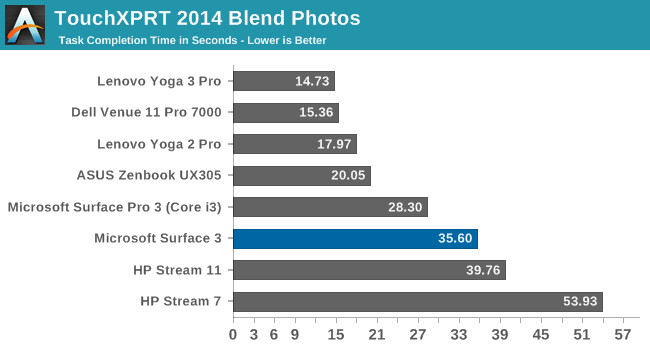
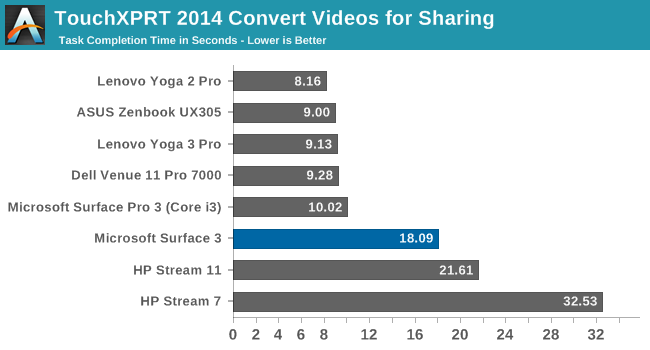
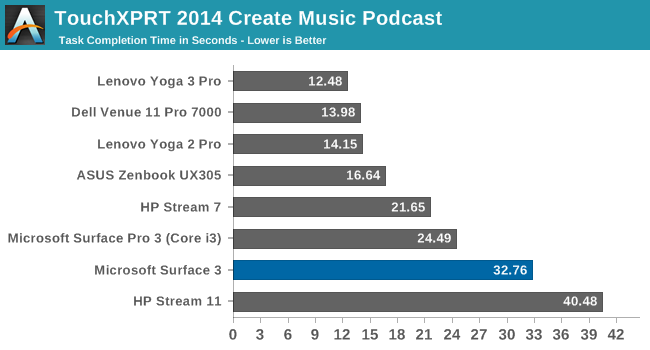
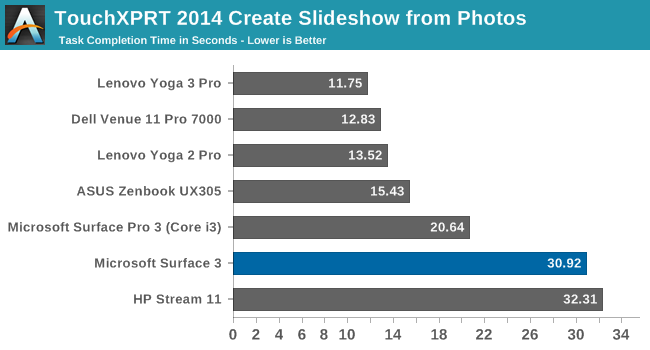
TouchXPRT 2014 is a benchmark that has a lot of burst workloads. The tasks are quick, but heavy, and it gives the processor a quick chance to cool off between each one so normally it is good about not running into throttling behaviour. The Atom processor is a long way off of the Core series here, with the exception of the i3 Surface Pro 3 which has no turbo capability. However there is a good bump in performance over the previous generation Atom in the HP Stream 7.
Cinebench

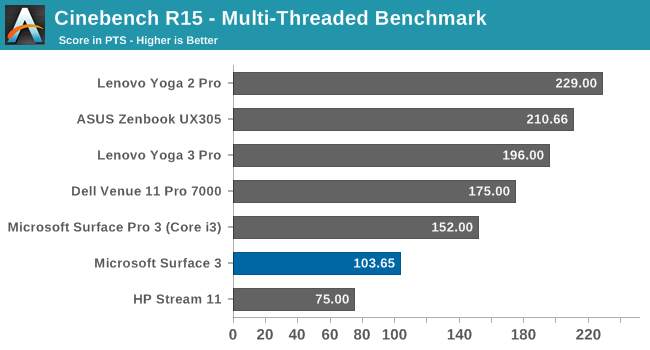
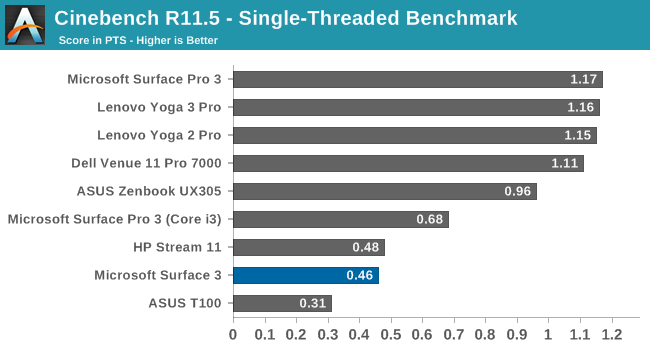
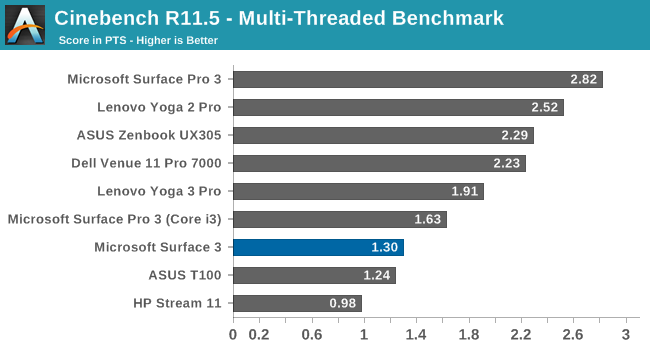
Cinebench is purely a CPU task, and it loves Instructions Per Clock (IPC) and frequency. There are two modes here with a single CPU run and all core run. It is still a long ways back of the Core i3 Surface Pro 3 on this test, and despite the Atom processor having four physical cores and the Core processors having only two physical and four logical cores, it is still not enough on the multithreaded run to really close the gap, although it does slightly. Looking at version 11.5 of this test, we have more data going back to older devices, so there are scores available from the ASUS T100 and there is a bump in performance compared to Bay Trail.
x264
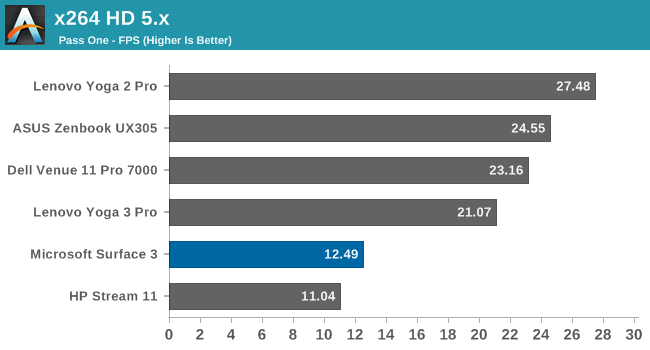

Once again this is a benchmark that prioritizes good IPC and frequency, along with multiple cores. The Atom struggles here compared to Core, which at this point should not be a surprise.
So clearly the new Cherry Trail CPU cores are not a giant leap in performance over Bay Trail, but like Haswell to Broadwell, there is a decent bump and the better manufacturing process helps increase overall performance due to the additional thermal headroom in the same power envelope. However when comparing it to the ARM competition, we only have a few data points but it does seem to be about on par with the top ARM CPUs at this time. Comparing devices across different operating systems is always difficult though.
Using the device day to day as a tablet though, performance was good. Yes, it could be better, and devices that use Core M are going to be able to run circles around Atom, but at the cost of additional heat. One of the nicest surprises of using this tablet was that it just never got warm at all, and the same cannot be said of any of the passively cooled Core M devices. Sure, when running very heavy benchmark loads, there was a bit of heat on the back, but it was never much more than around 30°C or so.
My experience was that when the Surface 3 felt slow, it was often not CPU bound but disk bound.










265 Comments
View All Comments
RafaelHerschel - Tuesday, May 5, 2015 - link
That is a weird statement. Whose fault is it then? You're right about one thing though, AMD is woefully behind Intel. I wish it wasn't so, but I don't see AMD making any real progress soon.At this point efficiency is king and Intel with their 'mobile first' philosophy is now becoming a viable alternative for the mobile market. Sadly I don't think that AMD has the budget to compete.
lilmoe - Thursday, May 7, 2015 - link
If we're talking efficiency, then ARM is king IMHO. The upcoming custom ARMv8 designs should give Intel a run for their money. AMD's Zen cores were developed with mobile first in mind with supposed great single threaded performance. It'll be interesting to see how things fold out. Too bad we'll have to wait a year at least for that.I should have been more specific though. I should have said that it wasn't "entirely" AMD's fault since process nodes of other fabs haven't been up to par. It'll be interesting to see AMD's Zen at 14nm vs Intel's Skylake at 14nm.
lilmoe - Thursday, May 7, 2015 - link
Oh, forgot to say that the initial point was about GPUs. Even with a process lead, Intel still can't come up with a decent GPU, even compared with ARM SoCs.LogOver - Monday, May 4, 2015 - link
Do Mali or PowerVR GPUs support DX at all? And if so, how good the support is? Last time I checked there were big issues with PowerVR Windows drivers. I'm not sure if these GPUs has any good support for something other than OpenGL ES. I guess the missing features are the reason that these GPUs are so "efficient".dusk007 - Monday, May 4, 2015 - link
According to the specs http://www.arm.com/products/multimedia/mali-perfor...Mali T760 supports OpenGL 3.1 and DirectX 11. Since Dx12 does not need different hardware that should be in the cards too. They all run the Windows mobile version so drivers are available. And features are all there. Intel is just not doing a very good job.
Considering the money and resources Intel has they really should do better.
LogOver - Monday, May 4, 2015 - link
According to the specs PowerVR GPUs also supports DX since series 5. They claimed DX 10.1 compatibility for sgx 545. I had netbook with Atom N2600 and it was the worst experience I ever had with laptops because of broken windows GPU drivers and non existing Linux drivers. I doubt that the situation with Mali or Adreno is any better. In fact, Intel does have new atoms with PowerVR GPUs (z35xx) but haven't hear about any planned windows device which are using these atoms. The reason is known...BlueBomberTurbo - Monday, May 4, 2015 - link
Check the GPU charts again. The HP Stream 7 is Gen 7, and gets absolutely blown out of the water on the GPU tests against the Surface 3.dusk007 - Tuesday, May 5, 2015 - link
Sure but I mean clock for clock, eu for eu.It is 16 eu against formerly 4. Of course it is faster but that is a lot of die space even on 14nm.
Where are differences like Kepler vs. Maxwell or AMD 290X vs the last GCN. Those just get more speed out of each execution unit. The faster Broadwell also only increase execution units but there should be plenty of other improvements possible before they catch up to the competition's efficiency. A lot of the Mali "tricks" can even be easily licensed.
Speedfriend - Tuesday, May 5, 2015 - link
"One would wish Intel would just license the Mali GPUs or PowerVR designs"They already use both of them in other chips. What Intel should do is buy Imagination, they would get the PowerVR IP which would improve Atom GPUs, it would give them leverage over Apple (who I guess are still some way off having their own GPU design) and they would get MIPS which they could develop as their ARM killer in the smartphone space.
watzupken - Monday, May 4, 2015 - link
I think Cherry Trail will be great in a low power PC for surfing net and some HTPC duties. Anyway, I am not sure if the poor battery life is a result of the SOC or Windows as well. I believe Windows is not exactly a very power friendly OS in the first place if you are using it all the time.